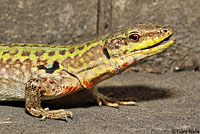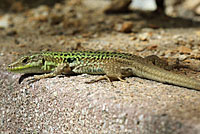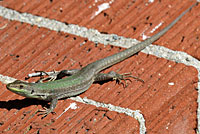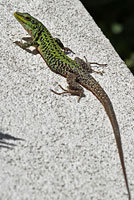|
This species has been introduced into California. It is not a native species.
|
| Two different subspecies of this lizard have been found so far in California, P. s. siculus and P. s. campestris |
|
Southern Italian Wall Lizard - Podarcis siculus siculus (Rafinesque-Schmaltz, 1810)
|
| Adult 1, Los Angeles County |
 |
 |
 |
 |
 |
 |
 |
| |
|
|
| Adult 2, Los Angeles County |
 |
 |
 |
 |
 |
 |
| |
|
|
| Below are more adult lizards found in Los Angeles County |
 |
 |
 |
 |
 |
 |
 |
 |
 |
 |
 |
 |
 |
 |
|
| Above photos are all adults from Los Angeles County © Gary Nafis |
 |
 |
 |
| Adult, San Pedro, Los Angeles County. © Jonathan Hakkim |
Adult, San Pedro, Los Angeles County. © Jonathan Hakkim |
Italian Wall Lizards have small granular scales on the back. |
More pictures and information at Lacerta.DE
|
| Suburban Los Angeles County Habitat |
 |
 |
 |
 |
 |
|
| |
| Short Video |
| |
 |
|
| A brief look at a few Southern Italian Wall Lizards in their suburban habitat. |
|
Northern Italian Wall Lizard - Podarcis siculus campestris (De Betta, 1857)
|
| |
 |
|
| |
Adult female, San Marcos, San Diego County © 2016 Andy Thomson
Photo voucher - San Diego Natural History Museum no. SDNHM_Herp- PC_5329 |
|
|
|
|
| Description |
| |
| Size |
Up to 3.5 inches long from snout to vent (9 cm).
|
| Appearance |
A medium-sized lizard with a long slender body with a large deep head, muscular limbs, and a tail up to twice the length of the body.
|
| Color and Pattern |
Highly variable in appearance - above is typically green, yellowish, olive, or light brown.
Some individuals change from green to brown in the summer.
The sides are often reticulated or checkered.
These markings may extend over the back.
When a vertebral streak is present, it is usually black.
Dorsolateral streaks are not clear.
Some individuals have a very faint pattern, or none at all.
The underside is whitish or greyish, sometimes with a green tint, usually without dark spots.
According to Guntram Deichsel: Sicilian Podarcis siculus may have red or orange coloring on the underside (as you can see on some of the lizards shown above.) Italian mainland Podarcis siculus are always plain white underneath. "The red on Sicilian ones may originate from genetic introgression of Podarcis wagleriana which occurs on Sicily only."
|
| Male / Female Differences |
Females are smaller than males, with a smaller head and a more obviously striped pattern.
|
| Life History and Behavior |
Activity |
Diurnal.
Tolerates living close to humans.
A good climber, often found on rock faces, walls, and buildings.
Hunts on the ground.
Capable of running long distances.
Uses cracks, rock piles, bushes, etc. for refuge.
Can be very abunant in its natural habitat, sometimes in densities of 10,000 - 16,000 individuals per hectare.
|
| Longevity |
| Individuals have lived 13 years in captivity. |
| Territoriality |
| Males are aggressive, and are known to attack other species of lizards that are green in color. |
| Diet and Feeding |
| Small invertebrates and vegetable matter. Has been known to eat its own young. |
| Predators |
| Preyed upon by birds, small mammals, snakes, and large insects. |
| Reproduction |
In its native habitat, breeding occurs when activity resumes in the spring.
Females breeding for the first time lay 1 or 2 clutches of eggs.
Females that have bred before lay up to 5 clutches of 2 - 12 eggs (typically 5 or 6) every 12 or so days.
Eggs hatch in 5 - 7 weeks.
Hatchlings are 1.2 - 1.4 inches snout to vent lenght (3 - 3.5 cm).
|
| Habitat |
In its native range, this lizard is found in grassy areas, road edges, open fields, the edges of woods, sandy areas, near the sea, and vineyards. Often found around human structures, in domestic gardens and in parks.
|
| Geographical Range |
Locations in California
Podarcis siculus - Italian Wall Lizard has so far been found in two areas in California:
1) A population introduced into San Pedro, Los Angeles County, in 1994 was documented in 2010. These were determined to be the subspecies Podarcis siculus siculus - Southern Italian Wall Lizard.
(See the Herpetological Review note below.)
2) In September of 2016 a population of Podarcis siculus campestris was documented in California in San Marcos, San Diego County. The lizards had been seen for at least five years in at least eight different residences in the area. It was estimated that the population is restricted to half a square kilometer. (Herpetological Review 47(3), 2016.)
The subspecies was identified as Podarcis siculus campestris - Northern Italian Wall Lizard by Guntram Deichsel of the website www.lacerta.de. This indicates that they were not introduced from the San Pedro population.
There are several observations on iNaturalist from July and August of 2016 in eastern Lost Angeles County in the vicinity of Whittier (the exact locations are obscured). There is another observation from August 2020 in South Whittier with a description of "an infestation of them" in the neighborhood. There has not been any information published about this population yet that I'm aware of.
Native Range
Podarcis siculus - Italian Wall Lizard
Native to Italy, Sicily, Corsica, Sardinia, Minorca, the south of France, Spain, the east Adriatic coast, Turkey, and many small islands in the Adriatic and Tyrrhenian seas. (Map)
Podarcis siculus siculus - Southern Italian Wall Lizard
The natural range of the subspecies is Southern Italy, Sicily, Sardinia, and several Aeolian and Pontine Islands.
Locations of Introduced Podarcis siculus
The species has been introduced into Libya and Tunisia.
Along with the California locations mentioned above, in North America this species has been introduced into the following locations, and probably more that I have not yet heard of:
- Topeka, Kansas
- Lawrence, Kansas
- Hays, Kansas
- Joplin, Missouri
(IRCF REPTILES & AMPHIBIANS • 22(1):43–45 • MAR 2015)
- Mt. Laurel, New Jersey
- Long Island, New York (the Bronx, Planting, West Hempstead, Garden City, Hampton Bays - and spreading)
- Hastings-on-Hudson, Westchester County, New York
- Greenwich, Connecticut (Herpetological Review 45(4), 2014)
- Boston, Massachusetts (Herpetological Review 48(1), 2017)
- Philadelphia, Pennsylvania - An established introduced population in Philadelphia was thought to have been extirpated, but it has been found to be still extant in low numbers within a few miles of the last reported site. Reports have also been made in the past two summers of a second site in the city. (Mark Miller, Pres. Philadelphia Herp Society, 7/17)
- Virginia, near Washington D.C.
- Orcas Island, Washington
(Herpetological Review 51(2), 2020)
- British Columbia, Canada (Hanke, G.F., and G. Deichsel. 2020. First record of an Italian Wall Lizard (Podarcis siculus) in British Columbia, Canada. Canadian Field-Naturalist 134(1): 60–63. https://doi.org/10.22621/cfn.v134i1.2483)
(A similar species Podarcis muralis - Common Wall Lizard, has also been introduced into the United States in Indiana, Kentucky, and Ohio. It has also been introduced onto Vancouver Island in British Columbia, examples of which you can see here.)
|
Discovery of the San Pedro Population
John Ivanov contacted Gary Nafis at Californiaherps.com 4/7/2010 to report that he had seen numerous Italian wall lizards in San Pedro, California, and sent a picture for confirmation. Gary informed Guntram Deichsel, a noted German Podarcis researcher who has documented several introduced populations of the lizards in North America, and southern California herper Jonathan Hakim. In a joint venture, they surveyed the site and identified the lizards as Podarcis siculus siculus. Guntram discovered that they had been introduced from Sicily in the year 1994.The origin was genetically confirmed by Werner Mayer of the Natural History Museum in Vienna, Austria.
Details are given in Deichsel, Guntram, Gary Nafis, and Jonathan Hakim. Herpetological Review Volume 41, Number 4 - December 2010 P. 513-14 which you can read directly below.
(Specific locality information has been removed to protect the species from being collected and released elsewhere.)
|
PODARCIS SICULUS (Italian Wall Lizard). USA: CALIFORNIA: Los Angeles Co.: San Pedro .... 23 April 2010 and 7 May 2010. Gary Nafis and Guntram Deichsel. Verified by Werner Mayer. Museum of Natural History in Vienna, Austria (photo voucher and tissue sample; catalogue number: NULA-1). Two additional voucher specimens are deposited at the Natural History Museum of Los Angeles County (LACM 180482–180483).
First verified record of P. s. siculus from the USA. Burke and Deichsel (2008. In Mitchell et al. [eds.], Urban Herpetology, pp. 347–353. Herpetological Conservation Vol. 3. SSAR, Salt Lake City, Utah) present an overview of occurrences of P. siculus in the U.S. and mention introduced P. siculus campestris only for New York, Pennsylvania, and Kansas. Stebbins (2003. A Field Guide to Western Reptiles and Amphibians. Houghton Mifflin Co., Boston, Massachusetts. 544 pp.) does not mention P. siculus in the area covered in this book.
Werner Mayer analyzed mtDNA from the tissue sample and submitted the result to GenBank (accession number HQ154646). A sequence of 887 bp of the mitochondrial cytochrome b gene differed only by 1% mismatches from respective sequences of P. s. siculus from both the city of Agrigento (on the SW coast of Sicily) and from the Monti Peloritani mountains in the northeast of the island. The difference Agrigento–Peloritani is 0.9% mismatches. Sequences from Sicily differ by 1.9–2.4% from sequences from the opposite Italian mainland, i.e., extreme southern Calabria (W. Mayer, pers. comm.).
Approximately 50% of the Californian individuals are of the “concolor” (syn. “olivacea”) morph characterized by plain green dorsa. Intergrades with faded, mid-dorsally lined (females) or faded checkered dorsa (males) are also present. Venters are plain white, orange, red, or white with beige spots. This inter-individual variation of coloration is consistent with a Sicilian origin: on the Italian mainland all P. s. siculus have plain white venters whereas on Sicily both plain white and colored venters occur (Henle and Klaver 1986. In W. Böhme [ed.], Handbuch der Reptilien und Amphibien Europas vol. 3 [Lacertidae III: Podarcis], pp. 254– 342. Aula Verlag, Wiesbaden).
JH surveyed the area several times after 7 May 2010, confining the occurrence to a ca. 300 m (NW–SE) x 400 m (NE–SW) rectangle centered at ... ... ... ... .... We estimate the total population size as over 1,000 animals. By interviewing residents, JH identified the person who originally introduced four females and three males, all adults, from Taormina on Sicily in September 1994. According to this person, “20 male and 24 female adult Southern Italian Wall Lizards, many juveniles, and lots of hatchlings co-exist together with 2–3 Southern Alligator Lizards and 4-5 Western Fence Lizards, all adults” in his/ her yard as of 29 June 2010. The total area of the person’s lot minus house footprint is 474 m2, yielding a population density of adult Southern Italian Wall Lizards of roughly one per 10 m2. In another resident’s garden measuring 72 m2, GD counted nine Podarcis, yielding a similar local density. In its home range, P. s. siculus can reach much higher densities. We recommend that the expansion of this alien species be monitored and possible interactions with native lizard species should be investigated.
Submitted by GUNTRAM DEICHSEL, Friedrich-Ebert-Str. 62, Biberach an der Riss, Germany DE-88400 (e-mail: Guntram. Deichsel@gmx.de); GARY NAFIS, (e-mail: grynaf@yahoo.com); and JONATHAN HAKIM, (e-mail: hakim.ndmva@gmail.com).
|


|
| Elevational Range |
On Sicily, sometimes ranges up to 6,500 ft. elevation (2,000 meters.)
|
| Notes on Taxonomy |
23 subspecies of Podarcis siculus are recognized.
Guntram Deichsel (of www.Lacerta.de) has informed me that while the name Podarcis sicula is still in common use for this species, Bohme & Kohler showed in a 2004 paper ** that since Podarcis is of variable gender, and the ICZN 1999 code states that a name of variable gender is to be treated as masculine, Podarcis should be treated as masculine. That makes the species name masculine: Sicula is feminine, and siculus is masculine, so the correct name for this species is Podarcis siculus, not Podarcis sicula.
** Do Endings of Adjective Flectible Species Names Affect Stability?
A Final Note on the Gender of Podarcis Wagler, 1830 (Reptilia, Lacertidae)
Wolfgang BOHME 8 Jorn KOHLER
Zoologisches Forschungsmuseum Alexander Koenig, Bonn, Germany
Bonner zoologische Beitrage 53 (2004)
|
| Conservation Issues (Conservation Status) |
The impact of this invasive species on native California lizards and other wildlife is not well known, however native lizards observed living in proximity with this species might suffer from the extra competition.
"Repeated surveys at other Southern California localities where nonnative Anolis carolinensis, Anolis sagrei, and Podarcis siculus occur have shown displacement of S. occidentalis as nonnative populations expand (Pauly, unpubl. data)."
(Gregory B. Pauly and Patrick D. Gavid. Geographical Distribution Note for Trachylepis quinquetaeniata in Los Angeles County. Herpetological Review 50(1), 2019.)
|
|
|
Taxonomy |
| Family |
Lacertidae |
Wall Lizards |
Cope, 1864 |
| Genus |
Podarcis |
Wall Lizard |
Wagler, 1830 |
| Species |
siculus |
Italian Wall Lizard |
(Rafinesque, 1810) |
Subspecies
|
siculus |
Southern Italian Wall Lizard |
(Rafinesque-Schmaltz, 1810) |
|
Original Description |
Rafinesque-Schmaltz, 1810
|
|
Meaning of the Scientific Name |
Podarcis: Greek - Agile, and Feet.
"Pod" = foot, pod arcis is the sharp (meaning agile) foot. (GD)
Sicula: Latin - from Sicily.
|
|
Alternate Names |
Podarcis sicula is still in common use, but Podarcis was determined to be male requiring the use of siculus instead of the female sicula.
Ruin Lizard
|
|
Related or Similar California Herps |
None
|
|
More Information and References |
Deichsel, Guntram, Gary Nafis, and Jonathan Hakim.
Herpetological Review Volume 41, Number 4 - December 2010 P. 513-14
Arnold, E Nicholas. Reptiles and Amphbians of Europe, 2nd Edition. Princeton University Press, 2002.
Guntram Deichsel, personal communications.
www.Lacerta.de
|
|
|
The following conservation status listings for this animal are taken from the January 2024 State of California Special Animals List and the January 2024 Federally Listed Endangered and Threatened Animals of California list (unless indicated otherwise below.) Both lists are produced by multiple agencies every year, and sometimes more than once per year, so the conservation status listing information found below might not be from the most recent lists. To make sure you are seeing the most recent listings, go to this California Department of Fish and Wildlife web page where you can search for and download both lists:
https://www.wildlife.ca.gov/Data/CNDDB/Plants-and-Animals.
A detailed explanation of the meaning of the status listing symbols can be found at the beginning of the two lists. For quick reference, I have included them on my Special Status Information page.
If no status is listed here, the animal is not included on either list. This most likely indicates that there are no serious conservation concerns for the animal. To find out more about an animal's status you can also go to the NatureServe and IUCN websites to check their rankings.
This lizard is not a native species and is not listed on the Special Animals List.
|
| Organization |
Status Listing |
Notes |
| NatureServe Global Ranking |
|
|
| NatureServe State Ranking |
|
|
| U.S. Endangered Species Act (ESA) |
None |
|
| California Endangered Species Act (CESA) |
None |
|
| California Department of Fish and Wildlife |
None |
|
| Bureau of Land Management |
None |
|
| USDA Forest Service |
None |
|
| IUCN |
|
|
|
|









































